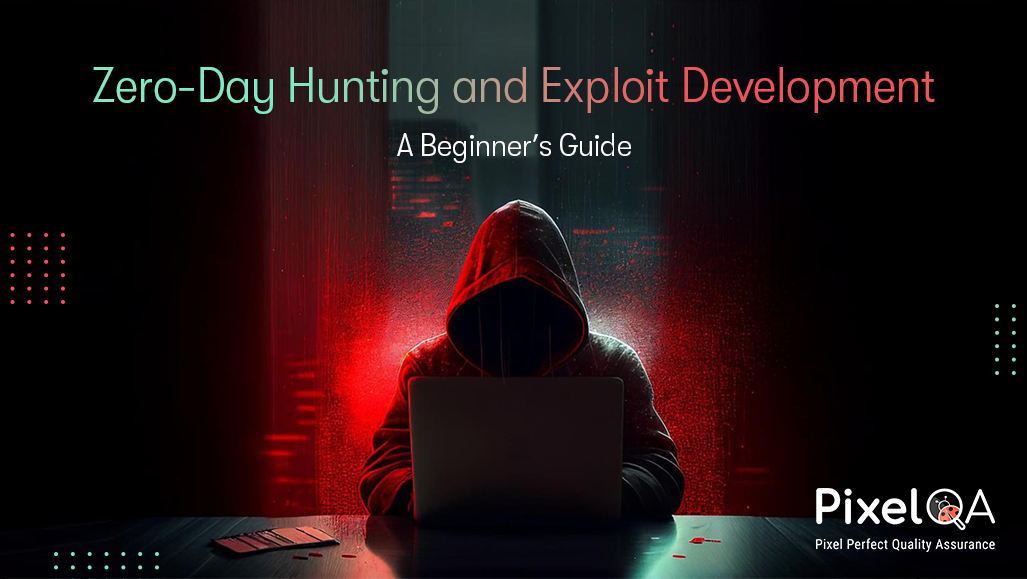
Zero-day vulnerabilities continue to be perhaps the most-dreaded threat in the dynamic realm of cybersecurity. These are security loopholes in programs that are unknown to the seller and, therefore, are incredibly lucrative both to ethical programmers and malicious attackers. The hunt for discovering these loopholes and, either patching or exploiting them is known as zero-day hunting, a critical focus for any reputable Security Testing Services.
Table of Contents
- A Zero-Day Vulnerability: What is it?
- Why Are Zero-Day Exploits So Dangerous?
- How Are Zero-Day Vulnerabilities Discovered?
- Turn weaknesses into attacks using exploit development.
- Ethical Considerations: Responsible Disclosure vs. Black Market Sales
- Famous Zero-Day Exploits in History
- How to Get Started in Zero-Day Hunting
- Conclusion
A Zero-Day Vulnerability: What is it?
A zero-day flaw is a problem in software, firmware, or hardware that nobody has yet encountered or corrected within the vendor world. As fixes are not currently available, cyber attackers can gain unauthorized access; execute malicious codes; or in some cases even compromise systems altogether. The terminology "zero day" simply speaks to the nature of developers needing zero days within which to provide a fix from the onset where the flaw exists.
Why Are Zero-Day Exploits So Dangerous?
- No Patches Available – Since the vendor does not know about the bug, there is no security update to patch the issue.
- High Success Rate – Since no defense mechanisms are in place, attackers can exploit the vulnerability undetected.
How Are Zero-Day Vulnerabilities Discovered?
1. Fuzzing
"Fuzzing" is an automated testing approach used to uncover computer vulnerabilities by introducing unexpected or randomly picked data into a program to see whether it crashes or behaves erratically.
- The fuzzing tools include AFL (American Fuzzy Lop), libFuzzer, and Peach Fuzzer.
- When a crash happens, the researcher examines it to see if there is anything he can take advantage of.
2. Reverse Engineering
Reverse engineering involves decompiling or disassembling software to understand its internal workings.
- Tools like IDA Pro, Ghidra, and Radare2 help in analyzing the program’s code structure.
- Security researchers look for memory corruption issues and logic errors that can be turned into exploits.
3. Static and Dynamic Code Analysis
- Static Analysis: Examining the source code or binary without executing it. This helps identify insecure coding practices.
- Dynamic Analysis: Running the software in a controlled environment and monitoring its behavior for unexpected actions.
4. Memory Corruption Testing
Common in zero-day exploits are memory corruption flaws include stack applying and use-after-free.
- These problems are found with tools including Valgrind, Address Sanitizer (ASan), and HeapViewer.
5. Manual Code Auditing
While automated tools are helpful, manual review of source code remains a powerful method for discovering zero-day vulnerabilities. Expert security experts look at logical flaws, incorrect input validation, and dangerous function calls that can provide access for attackers.
Turn weaknesses into attacks using exploit development.
Finding a zero-day vulnerability calls for developing an exploit, a piece of code meant for criminal activities using the vulnerability.
1. Writing Proof-of-Concept (PoC) Exploits
A Proof-of-Concept (PoC) exploit is a script or program demonstrating that a vulnerability is exploitable.
- Written in languages like Python, C, or Assembly.
- Helps security teams understand the risk and develop patches.
2. Exploit Mitigation Bypasses
Modern operating systems have security features that make exploitation harder:
- DEP (Data Execution Prevention): Prevents the execution of memory areas that are not executable.
- ASLR (Address Space Layout Randomization): Randomizes memory addresses to prevent predictable exploitation.
- Canaries & Stack Protection: Detects and blocks memory corruption exploits.
To get beyond these safeguards, exploit developers employ JIT Spraying and ROP (Return Oriented Programming) methods.
3. Privilege Escalation
An attacker may only have restricted access to a system even if they manage to get inside. Exploits for privilege escalation aid in obtaining complete system control.
- Exploiting SUID binaries, kernel vulnerabilities, or misconfigurations to escalate root access.
4. Weaponization of Exploits
After developing a PoC, attackers or security professionals may integrate it into tools such as Metasploit for broader penetration testing.
Ethical Considerations: Responsible Disclosure vs. Black Market Sales
Cybercriminals and state-sponsored actors purchase exploits for espionage or assaults on the black market, where zero-day vulnerabilities may fetch millions of dollars. But ethical hackers take a responsible disclosure stance:
1. Report to the vendor: Notify the software company privately.
2. Give time for a patch: Vendors typically take 90 days to release a fix.
3. Public disclosure: If the vendor refuses to fix it, ethical hackers may disclose it responsibly.
Famous Zero-Day Exploits in History
Stuxnet (2010)
- Used multiple zero-days to sabotage Iran’s nuclear program.
- Exploited Windows vulnerabilities to spread via USB drives.
EternalBlue (2017)
- NSA-developed exploit leaked by Shadow Brokers.
- Used by WannaCry ransomware to infect millions of Windows PCs.
Google Chrome Zero-Days (2023-2024)
- Google regularly patches zero-day vulnerabilities exploited in the wild.
- Many involve JavaScript engine flaws and sandbox escapes.
How to Get Started in Zero-Day Hunting
If you’re interested in zero-day research, here’s how to begin:
1. Learn Programming & Security Fundamentals
- Languages to Learn: C, C++, Python, Assembly.
- Security Topics: Memory corruption, privilege escalation.
2. Practice on Vulnerable Machines
- Hack The Box, TryHackMe, and VulnHub offer labs to test skills.
- Set up Metasploitable, Damn Vulnerable Web App (DVWA), and Exploit Education.
3. Use Open-Source Exploit Development Frameworks
- Metasploit: Automates exploit development.
- GDB & WinDbg: Debugging tools for analyzing crashes.
- Radare2 & IDA Pro: Reverse engineering.
4. Join Security Research Communities
- Take part in bug bounty initiatives.
- Attend cybersecurity conferences like Black Hat and DEFCON.
- Play Capture the Flag (CTF) games to hone your abilities.
Conclusion
Zero-day hunting and exploit creation demand a high level of technical expertise, persistence, and ethical responsibility. While the field offers significant rewards, it also presents moral challenges. By adhering to responsible disclosure practices, penetration testers and professionals offering Software Testing Company can refine their skills in advanced cybersecurity techniques while contributing to a safer digital world.
If bug hunting, reverse engineering, and exploit development excite you, start small, practice consistently, and engage with the security community. Who knows? You might just uncover the next major zero-day exploit!
About Author

Rushi Mistry is a Security Tester at PixelQA with a focus on cybersecurity. He is passionate about IoT penetration testing and is working towards obtaining a CISSP certification, with the ultimate goal of becoming a Chief Information Security Officer (CISO).

_638780456438044444.png)